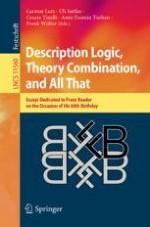2019 | Buch
Description Logic, Theory Combination, and All That
Essays Dedicated to Franz Baader on the Occasion of His 60th Birthday
herausgegeben von: Carsten Lutz, Prof. Uli Sattler, Prof. Cesare Tinelli, Anni-Yasmin Turhan, Prof. Frank Wolter
Verlag: Springer International Publishing
Buchreihe : Lecture Notes in Computer Science




